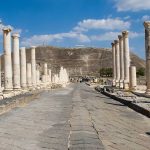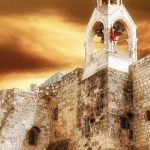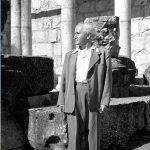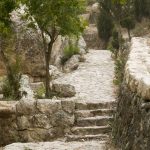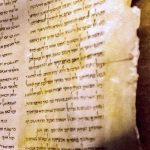Capernaum
Capernaum was a fishing village established during the time of the Hasmoneans, located on the northern shore of the Sea of Galilee. It had a population of about 1,500. Archaeological excavations have revealed two ancient synagogues built one over the other.
Source: Wikipedia
The town is cited in all four gospels (Matthew 4:13, 8:5, 11:23, 17:24, Mark 1:21, 2:1, 9:33, Luke 4:23, 31,7:1, 10:15, John 2:12, 4:46, 6:17, 24, 59) where it was reported to have been the hometown of the tax collector Matthew, and located not far from Bethsaida, the hometown of the apostles Simon Peter, Andrew, James and John. Some readers take Mark 2:1 as evidence that Jesus may have owned a home in the town, but it is more likely that he stayed in the house of one of his followers here. He certainly spent time teaching and healing there. One Sabbath, Jesus taught in the synagogue in Capernaum and healed a man who was possessed by an unclean spirit (Luke 4:31–36 and Mark 1:21–28). This story is notable as the only one that is common between the gospels of Mark and Luke, but not contained in the Gospel of Matthew (see Synoptic Gospels for more literary comparison between the gospels). Afterward, Jesus healed Simon Peter’s mother-in-law of a fever (Luke 4:38–39). According to Luke 7:1–10 and Matthew 8:5, this is also the place where Jesus healed the servant of a Roman centurion who had asked for his help. Capernaum is also the location of the healing of the paralytic lowered by friends through the roof to reach Jesus, as reported in Mark 2:1–12 and Luke 5:17–26.
In Matthew 9:1 the town is referred to only as “his own city”, and the narrative in Matthew 9:2–7 does not mention the paralytic being lowered through the roof. Most traditional biblical commentators (e.g. Bengel, Benson and the Jamieson-Fausset-Brown Bible Commentary) assume that in Matthew 9:1-7 “his own city” means Capernaum, because of the details that are common to the three synoptic gospels.[8]
According to the Synoptic Gospels, Jesus selected this town as the center of his public ministry in Galilee after he left the small mountainous hamlet of Nazareth (Matthew 4:12–17). He also formally cursed Capernaum, along with Bethsaida and Chorazin, saying “you will be thrown down to Hades!” (Matthew 11:23) because of their lack of faith in him as the Messiah.
Source: Wikipedia
Good to Know
Country
Visa Requirements
Languages spoken
Currency used
Area (km2)




